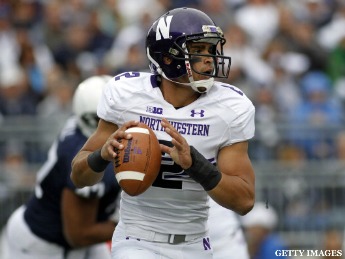
When NFL linebacker O'Brien Schofield was a student-athlete at Wisconsin, he ran into a problem toward the end of every month: His stipend was running out and the rules surrounding training table food were strict.
After all, without a ton of help from his parents, Schofield had more than a few bills to pay: A cell phone. Rent. Gas money. Groceries. And of course the myriad of other things that pop up on the must-have list in college.
So, with many of his teammates, he would pool together change from his car or around his room to try to afford a meal off the dollar menu at McDonald's.
"There were times," said Schofield, who just signed with the Seahawks, "when you were just in survival mode."
Support for the lawsuit that former UCLA basketball player Ed O’Bannon filed against the NCAA and EA Sports for using his likeness without compensation has heated up this year. College players and coaches are coming out in droves to emphasize the premise of O'Bannon's case. As Texas coach Mack Brown said at Big 12 media days: "These players are killing themselves and at Texas last year we made $163 million."
The argument against paying players is that they receive scholarships -- often valued at tens of thousands of dollars plus stipends -- which are more than their free market value is worth. Or that paying certain players would take away most schools' abilities to compete.
But contrary to the stereotypes of playing college football, often glorified in the movies, interviews on media days this year paint a much bleaker picture in the life as a player when you don’t accept illicit benefits or have a family that can send extra money when the stipend runs out.
"We got $1,100 a month,” Schofield said of his time at Wisconsin. “You pay rent at $650, you pay your cell phone bill and if you have a car up there you have to pay for parking. How do you pay for your bills and groceries?"
Players at the end of the semester would pull their money together to buy as much cheap food as they could to split. And players whose parents provided them with more extra spending money, or had some leftover from summer jobs -- NCAA bans in-season work -- would cook larger meals for their teammates.
In recent years, it's gotten better, he said, after Wisconsin went to three consecutive Rose Bowl games and boosted its ranking. “It’s a lot different now,” he said. “They have meal plans now and I’m happy for those guys because when we were there it wasn’t like that.”
It's still not exactly paradise, one current Badgers' player told the Omaha World-Herald.
“There's absolutely a disconnect when administrators and people are making a lot of money and players' families can't come to the games,” current Wisconsin player Chris Borland told the newspaper. “There are guys eating PB and J and Ramen noodles more than they should based off of what they contribute.”
There still are many schools in Division I without similar meal plans in place, something Arizona coach Rich Rodriguez addressed earlier this week. “They should pass the rule tomorrow that you can feed all your athletes,” he said, according to Sports Illustrated writer Pete Thamel. “Three meals a day all year round."

It's a simple and perhaps almost scary thought that student-athletes aren’t getting at least the same three meals a day that most students do. The stereotypes of football players getting free food wherever they go from admiring fans, Schofield said for most schools, it happened far less often than anyone thought. “There’s a party that's going to have food?” he said. "Oh you’ll be there. You never turn down free food. Any (school-sponsored) multi-cultural event you’d see a lot of athletes there because of the free food.”
Northwestern quarterback Kain Colter, a supporter of the NCAA paying athletes, told reporters at Big Ten Media Days he was frustrated with making the NCAA hundreds of millions without much help for emergencies -- like earlier this year when his car was hit in a hit-and-run accident, according to the World-Herald.
"Where am I going to get that money?” he said.
Colter, according to his coach Pat Fitzgerald, is better off than many players. "The stipend at our place is a heck of a lot more than it is at other schools because of the cost-of-living adjustment," Fitzgerald told reporters, according to the Chicago Sun-Times. "And I’m not going to lie to you -- I use that like you have no idea in recruiting."
Even if athletes can get their basic needs met, the idea of a social life of free drinks at any bar you're recognized is also far from true at most schools, said Schoenfeld.
As is the idea of throwing away money for what many college students have: Video games, movie tickets, etc. In an ironic twist on the O'Bannon lawsuit, when it came to the soon-to-be-renamed EA Sports college football game was that some players would have to pool their money together to buy it.
"I wanna buy the new NCAA game but I also don't wanna be poor till September... My likeness is on the game why do I have to pay for it?” Missouri defensive tackle Lucas Vincent wrote last month on Twitter.
Schofield said during his time in college he and his teammates would also pool together money to buy the game and quickly match up what they believed their uniform and number to see where they measured up.
"You definitely want to see where you’re ranked,” Schofield said. “That was everything."
Even if shelling out the money to get it meant another hurdle against paying for dinner later that night.




